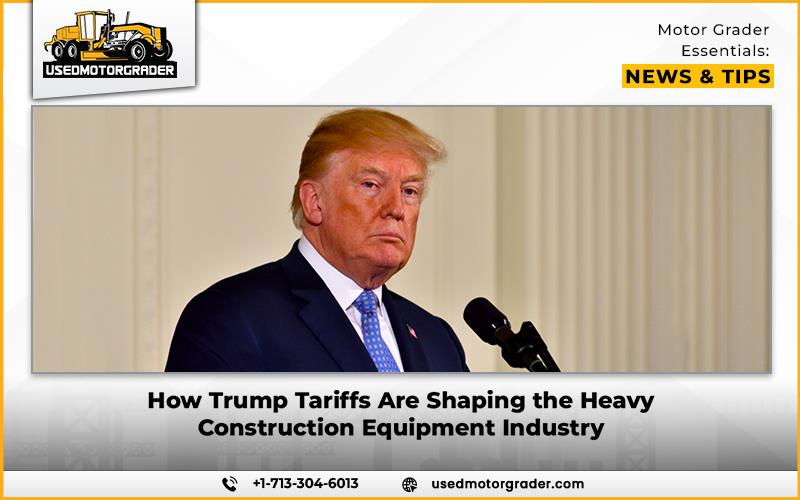The current tariff imposition is a 10% flat tax on steel and aluminum imports became a border measure that affected steel and aluminum importers from all nations. China received the harshest punishment as the U.S. imposed severe reciprocal tariffs on China while targeting the nation as the most affected country. The products had to deal with excessive taxation, which exceeded 100%. Although some tariffs were later changed or dismissed, they initially created extended modifications in the global pricing system and global trade operations. The trade war initiated by these measures launched between the United States and China will profoundly affect the construction sectors of both nations.
Both China and the United States utilize unsecured supply routes. To obtain fundamental construction equipment materials and machines for their heavy construction industries. The unnecessary trade barriers will negatively impact productivity rates along with economic growth. While creating imminent threats to construction work and job opportunities on each side of the border.
Constructing heavy equipment, for instance, excavators, bulldozers, and loaders, demands massive quantities of steel, metal, and aluminum. Combined with production elements from foreign sources. Manufacturers either took the price increase directly by themselves or transferred it to their purchasing clients after tariffs affected their materials. The situation produced inadequate results for contractors who operated with fixed-price agreements because neither alternative was sufficient.
Impact on Construction Material Costs
The reintroduction of trade obstacles triggered an important surge in the prices of construction materials. In the early part of 2025 nonresidential material prices showed a 9% annual growth rate as construction inputs reached 41% higher than February 2020 levels. Construction budgets and schedules directly suffer from this price growth which affects structural steel as well as aluminum components and many other materials.
A project worth $375 million will incur additional expenses of $6.2 million because of steel and aluminum duty increases. The funding challenges force contractors to adjust their definition of project feasibility as they search for cost reduction methods.
Uncertainty for Raw Materials Market
Pricing markets became unstable as a direct result of tariff implementation which created the main obstacle. High instability prevailed in the manufacturing sector as they attempted to establish fixed prices on construction equipment. Price changes in raw materials emerged as a result of international trade legislation. These changes disrupted the procurement procedures followed by numerous heavy construction equipment dealers and contractors.
Prior to the establishment of trade tariffs contractors adopted fixed-price contracts to absorb increased expenses of materials and equipment costs. Businesses paid for higher expenses since their contracts lacked procedures for price adjustment or escalation.
Price escalation clauses and change-in-law provisions often appear in complex infrastructure projects and energy infrastructure development. Smaller construction projects for residential and commercial purposes typically lack such protection which makes general contractors vulnerable to increased costs.
Contracting Under Pressure
The trade uncertainty period made companies review their risk allocation approaches. Industry stakeholders started raising important questions about who should pay for material expense increases and whether tariff changes equated to legal changes.
Trade provisions, which formerly operated as standard text, now demanded full attention from all parties. Contractors investigated the extent of legal change clauses to determine their coverage of international trade measures such as tariffs, alongside other local legal adjustments.
At the same time, subcontractors’ involvement and suppliers’ engagement required immediate attention. Companies gained better control of uncertain territory through direct disclosure practices regarding supply chain issues affecting delivery schedules and prices.
Lasting Effects on Equipment Dealers and Buyers
Tariffs created disruptions across the entire equipment market by affecting both new and used equipment sales. The used heavy construction equipment marketplace expanded rapidly because new machines were both more costly to obtain and harder to acquire. Used equipment prices experienced inflation because of which loaders and dozers and excavators were harder to acquire while rental rates increased proportionately.
Dealers needed fast adjustments by obtaining equipment from various regions with extended shipping times while developing innovative inventory management methods. Smaller contractors experienced three challenging options: they could pay the rising costs, delay acquisitions, or investigate rental options in the constrained market.
What’s Next?
The volatility of foreign trade negotiations leaves the construction business on edge. In the future, construction businesses are becoming increasingly conservative in securing equipment and material purchases. They’re also writing better contracts for themselves, those that consider cost fluctuations of materials and political turmoil.
Final Thoughts
The Trump era tariffs remapped construction firms’ perspectives on risk, supply chains, and the contract phase. Whether you’re a dealer, contractor, or manufacturer, the takeaways from this era are evident: volatility can strike in an instant, and readiness is no longer unrestricted.


